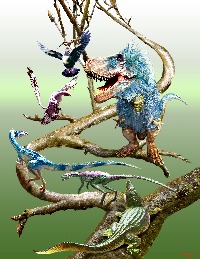Testing the locomotor superiority hypothesis for early dinosaurs
Professor John Hutchinson has been awarded an ERC Advanced Investigator grant called "Testing the locomotor superiority hypothesis for early dinosaurs".
This project seeks to unify evolutionary and biomechanical research by achieving a “functional synthesis” in evolution that causally links phenotypes (anatomy) to actual performance. Did early, bipedal dinosaurs evolve advantages in their locomotor performance over other Late Triassic archosaurs (“ruling reptiles”)? This “locomotor superiority” hypothesis was first proposed to explain what made dinosaurs distinct from other Triassic taxa, perhaps aiding their survival into the Jurassic. However, the hypothesis remains untested or unfairly dismissed.
The study will test this question for the first time, but first we need to develop the best tools to do so. Extant archosaurs (crocodiles and birds) allow us to experimentally measure key factors (3D skeletal motions and limb forces; muscle activations) optimizing performance in walking, running, jumping, standing up, and turning. We will then use biomechanical simulations to estimate performance determinants we cannot measure; e.g. muscle forces or lengths. This will refine our simulations by testing major assumptions and will validate them for studying extinct animals, overcoming the obstacle that has long limited researchers to qualitative, subjective morphological inferences of performance. Next, we will use our simulation tools to predict how ten Late Triassic archosaurs (dinosaurs and their cousins; quadrupeds and bipeds of disparate forms) may have moved, and to compare how their performance in the five behaviours related to locomotor traits, testing if the results fit expected patterns for “locomotor superiority.”
This study pushes the frontiers of experimental and computational analysis of movement by combining detailed measurements of performance with modern digital tools, to predict how form and function are coordinated to optimize performance. Our rigorous, integrative analyses will help to further revolutionize evolutionary biomechanics, enabling new inquiries into how behaviour relates to underlying traits or even palaeoecology, environments, biogeography, biotic diversity, disparity or other metrics.

You may also be interested in:
-
New RVC research reveals correlation between livelihoods in the Bolivian Amazon and perceptions of jaguars
New research from the Royal Veterinary College (RVC), looking at how livelihoods influence views …

-(CA-ACEAA).jpg?v=638981101827551969)